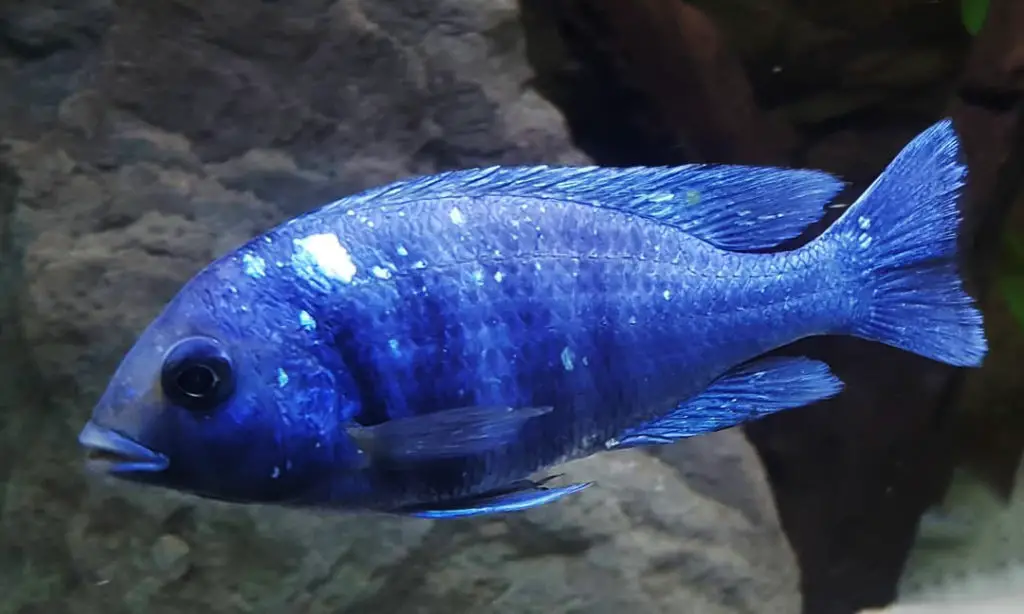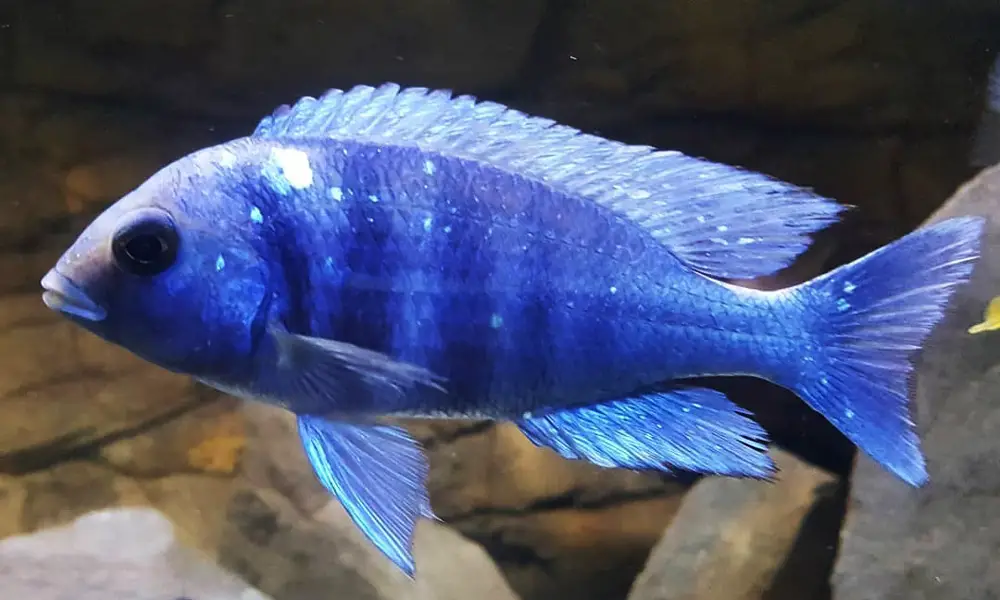A close relative to Mdoka White Lip, Star Sapphire Cichlid, reminds us of a stunning constellation encrusted in a sapphire gemstone. This beautiful fish is widely-appreciated among hobbyists for its vibrant blue coloration and enchanting behavior.
Moreover, this species is ideal for those aquarists looking for a less rough-and-tumble aquarium. They are maternal mouthbrooders, and their coloration intensifies when they are ready to spawn.
If you have made up your mind about keeping these eye candies in your aquarium, make sure you are well-acquainted with all the fundamentals. Scroll down to the bottom and learn more about the care guidelines, including ideal tank mates, diet, water parameters, and tank size.
Species Summary
Star sapphire cichlids (Placidochromis sp. “phenochilus Tanzania”) are among the most popular haps in the world, especially males. These fish are endemic to the shallow habitat along the shoreline between Makonde and Lupingu part of the Tanzanian in Lake Malawi.
Its genus, Placidochromis, currently has 43 described species, in which most members live in the open sandy areas of the lake. P. phenochilus was firstly described by Dr. Ethelwynn Trewavas in 1935.
Like many other African Hap Cichlids, this specie has two well-known variants, including:
- Placidochromis sp. “phenochilus Tanzania” (Star Sapphire Cichlid)
- Placidochromis sp. “phenochilus Mdoka” (Mdoka White Lips Cichlid)
Their common names do a great job describing the distinct differences – Star Sapphire Cichlids have blue sparkles all over their body, whereas Mdoka White Lips from Mdoka to Chirwa Island have a solid blue body with white lips.
These fish are sometimes labeled as Placidochromis Electra (Deepwater Hap) in the trade, the most common imported hap in this genus, and were formerly considered a single variable species.
| Scientific Name: | Placidochromis sp. “phenochilus Tanzania” |
| Common Name: | Star Sapphire Cichlid |
| Origin: | Lake Malawi |
| Aggressiveness: | Aggressive |
| Max Size: | 10 inches |
| Lifespan: | 5 – 8 years |
| pH: | 7.8 – 8.6 |
| Temperature: | 78-82°F (25.6-27.8°C) |
| KH: | 12 – 18 |
| Tank Size: | Minimum: 75 Gallons | Optimal: 125 Gallons |
| Diet: | Carnivores |
Appearance

This species is highly sought after for its appealing appearance and undemanding behavior. The colors of this cichlid get darker and more intense with age. Male adults boast a vibrant blue with exceptionally contrasting metallic white blotches.
The best thing about these species is that every male looks different and features more or less white spotting. On the other hand, females are generally far less colored than males. They have silver coloration with a black throat, blue sheen, and black barring. Females also get intense coloration with age and can develop a fair amount of blue as they grow older.
Furthermore, females don’t have glittering white and blue spots, but they feature vertical bars, making them different from their male counterparts.
[amazon box=”B079VN96C9″]Star Sapphire Cichlid Size
The maximum size of a Star Sapphire Cichlid is around 10 inches in standard length. Females tend to be slightly smaller than males and can attain up to 6 inches of maximum size.
Star sapphire cichlid is a slow-growing species compared to other haplochromis. The fish starts turning blue at 3 inches and begins to get its spotting when they have attained 4 to 5 inches. Generally, males will take 4 years to reach maturity and fully show their light blue sparkles.
Lifespan
The average lifespan of a Star Sapphire cichlid is between 5-8 years if provided with proper care.
Of course, this is just an estimate. The key to a long and healthy life for your fish is regular tank maintenance, a nutritious diet, and suitable tank mates. We’ll get into those specifics in a bit.
Care & Tank Setup
Unlike most Haps, the Star sapphire cichlid is one of the most peaceful fish. In the wild, Placidochromis sp. “phenochilus Tanzania” is usually referred to as ‘followers.’ These cichlids love to follow larger species, like Fossorochromis rostratus or Taeniolethrinops praeorbitalis, and feed on the small invertebrates that these fish leave behind.
As a result, they don’t need to defend a territory and can be easy-going fish that can do well in harmony with congeners and other fish.
Although these are undemanding fish, a Star Sapphire cichlid will still need some specific care to stay healthy and thrive in your aquarium.
Here are some Star Sapphire Cichlid care guidelines that you should consider before adding them to your tank.
Tank Size
The minimum tank size for a group of 5 to 7 Star sapphire cichlids is a 75-gallon tank (48″ x 18″ x 21″), while the optimal tank size should be 125-gallon (72″ x 18″ x 21″). Thanks to their large adult size and active nature.
Larger tanks will provide your fish with plenty of room to swim around and make it easy for you to observe a group of blue followers. If you want to keep them in a large group, then you’ll need an even larger tank.
Water Parameters
These fish come from the shallow, sediment-rich habitat of Lake Malawi, where the water chemistries and parameters are relatively stable.
They generally prefer hard, alkaline water to thrive. But, they are not suited to a full brackish water tank. Keeping the right water parameters is mandatory to make them healthy and help them display their true coloration.
Ensure that water quality is in good shape, like any other Malawi Cichlids; these fish are very sensitive to poor water quality. Poor conditions cause stress, which is considered the main reason for Malawi Bloat.
Here’re mentioned the exact parameters to follow.
- pH: 7.8 – 8.6
- Water Temperature: 78-82°F (25.6-27.8°C)
- Hardness: 12 – 18
- Ammonia: 0 ppm
- Nitrite: 0 ppm
- Nitrate: <20 ppm
Additionally, sapphire cichlids are very messy eaters and produce a large amount of waste. So, maintain the filtration system and do regular partial water changes of at least 20% – 40% every week to keep the water quality high.
[amazon box=”B000255NCI”]Decor
Star Sapphire Cichlids stay in the sediment-rich habitat; therefore, they prefer adding open expanses of sand and a few rocky areas to the aquarium that houses these species. You can use the decor like rocks to create a sturdy structure, stretching from the tank base to the water surface.
Adding coral sand and Aragonite is suggested to maintain the water hardness and pH. Furthermore, these species show their true colors on the darker substrate, adding the same accordingly.
Food
As we mentioned earlier, these fish are the following foraging species. So, in the wild, they mainly sift through the sand behind these large fish, looking for edibles.
In captivity, they are carnivores who readily accept various meaty frozen food items, including vitamin-infused brine shrimp, mosquito larvae, and Mysis shrimp.
Adults can easily consume krill, lancefish, prawns, whitebait, etc. In addition to these, do not forget to feed them with a combination of premium-quality flake and sinking cichlid pellets.
When they reach about 3-4 inches, flakes become too messy and should be discontinued.
Star Sapphire Cichlid Tank Mates
Star Sapphire Cichlids are fairly peaceful as compared to others.
For a tank that is smaller than 75 gallons, it’s best to maintain them in groups, one male and several females, or you can mix a group of females and a bunch of yellow labs.
Of course, you can add them with suitable tank mates in a community tank, such as Aulonocara species, Synodontis Catfish, and other mildly-aggressive Haps. You need to make sure that whatever tank mates you are adding must be identical in temperament and size so that they can stay together peacefully.
To avoid hybridization, if you intend to breed Star Sapphire Cichlids, you should not keep them with their close relative, the Deep Water Hap (Placidochromis Electra).
Looking for some possible tank mates for a community tank? Here are some of the Star Sapphire Cichlid companions you can try:
- Red Empress (Protomelas taeniolatus)
- Deep Water Hap (Placidochromis Electra)
- Redfin Hap (Copadichromis borleyi)
- Flavescent Peacock (Aulonocara stuartgranti)
- Yellow Lab Cichlid (Labidochromis caeruleus)
Breeding
Star sapphire cichlids are a maternal mouthbrooder. They will readily breed in captivity, and the breeding process is relatively easy. However, you do need to provide them with the right tank conditions and setup to make sure that everything goes smoothly.
These fish will start to breed at around four inches long. When it comes to Star Sapphire Cichlid breeding, always keep a ratio of one male to several females. This will help reduce aggression and allow the males to spread their attention evenly among the females.
When they’re ready to spawn, the coloration of the male will become more intense, and he will start to build a nest out of flat rock or excavate a small pit in the sand. Once the nest is complete, he will then start to court the females.
When spawning, they will circle each other until the female is ready to release her eggs. Once she does (around 20-50 eggs), the female will then pick up the eggs in her mouth and incubate them until they hatch. This process takes around three weeks.
After the fry are free-swimming, they will be large enough to eat baby brine shrimp.
Final Thoughts
That concludes with the Star Sapphire Cichlid care guidelines. We hope our in-depth research will help you with all the basic things you should be careful of while adding these species to your tank.
These beautiful fish go through an incredible transformation with age, which in turn makes them a desirable pet for all. They grow slowly compared to other haplochromines and get their true coloration when they mature.
Watching these vibrant Star Sapphires is a sight to behold, and they turn your ordinary tank into an eye-catching centerpiece. Moreover, these are less demanding, so you can easily add them to your tank without thinking much.
As always, if we miss anything, or if you have any questions regarding Star Sapphire cichlid care, please don’t hesitate to reach out to us in the comment section below. We would love to hear from you!

Those colors are incredible! and one of the most definitely stunning fishes. The beauty in time is like a fine wine.